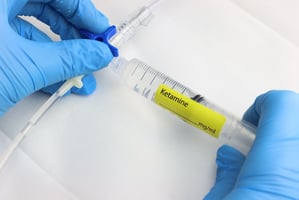The antidepressant effects of ketamine appear to depend on activation of the brain’s opioid...
Meta-Analysis Highlights Ketamine’s Rapid, Yet Transient Antidepressant Effect
 |
For the study, researchers from the APA Task Force on Novel Biomarkers and Treatments scoured the literature for placebo-controlled, double-blind, randomized clinical trials examining ketamine and other NMDA antagonists in the treatment of depression.
The analysis of seven trials (encompassing 147 ketamine-treated participants) confirmed that a single intravenous infusion of ketamine consistently produced a rapid and robust antidepressant effect that peaked within 24 hours of administration, accompanied by brief psychotomimetic and dissociative effects. However, by day 7, these antidepressant effects were largely diminished. An additional five trials examining ketamine’s ability to augment electroconvulsive therapy (ECT) (89 ketamine-treated patients) revealed that ketamine accentuated the antidepressant effects of ECT following an initial treatment but not at the conclusion of the ECT treatment regimen.
The task force also analyzed the findings of several randomized, controlled trials of other NMDA antagonists, including lanicemine, memantine, and N2O, and two partial agonists at the NMDA coagonist site, d-cycloserine and rapastinel. They found that while lanicemine, memantine, and N2O—which bind to the receptor at the same site as ketamine—failed to consistently demonstrate efficacy, d-cycloserine and rapastinel significantly reduced depressive symptoms without psychotomimetic and dissociative effects.
“The results from existing NMDA receptor antagonist studies are decidedly mixed,” said D. Jeffrey Newport, M.D., M.S., M.Div., a professor of psychiatry and behavioral sciences at the University of Miami Miller School of Medicine and member of the APA Task Force on Novel Biomarkers and Treatments. “Therapeutic response to ketamine is rapid and robust but fleeting at best. … Results with other NMDA antagonists have unfortunately been largely disappointing. Nevertheless, early experience with ketamine suggests that glutamatergic strategies for treating depression warrant further investigation,” he told Psychiatric News.
“Although the antidepressant effect of ketamine appears to be clear, it’s increasingly widespread use in the community is of concern for several reasons, including the virtual absence of any data on serial administration, dosing schedules, tachyphylaxis to the therapeutic effects, and need for cardiac monitoring during administration, as well as the concerns of abuse liability and neurotoxicity,” said Charles Nemeroff, M.D., Ph.D., the Leonard M. Miller Professor and Chairman of the Department of Psychiatry and Behavioral Sciences at the University of Miami Miller School of Medicine and Task Force member. Additionally, Nemeroff told Psychiatric News, “The precise mechanism of action of ketamine’s antidepressant effect remains obscure.”
Nemeroff said the Task Force is working on developing recommendations for ketamine use. “This is important because of the unusual situation in which we find ourselves, namely a drug approved for one use by the FDA has found its way into the psychiatric pharmacopoeia without the usual high standards and wealth of data in large clinical studies required for FDA approval,” he said.
For related information, see the Psychiatric News article “The Ketamine Challenge: When Practice Leaps Ahead of Science.”
(Image: Hospira, Inc.)





